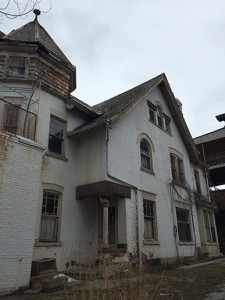Advertisements for technology sales and services cover the front windows of a condemned building on the corner of Fourth and Vine streets. Ripped up floors sit on top of each other like puzzle pieces, and decaying walls suggest that no business is taking place inside of this decrepit building.

This abandoned building is one of the few intended to become a thirteen story high-rise. Located next to Blue Sky Cafe, these renovations are a part of an increase in residential construction in the area. (Raven Atkins/B&W photo)
On the surface, this building represents the struggle many local businesses face in the wake of the fallen Bethlehem Steel and recent economic recession. Taking a closer look, this building is significant because it is one of a handful of properties on the South Side owned by local developer Dennis Benner.
Benner has visions to transform the South Side into a vibrant college town that will be inviting to students and young professionals. He plans to build a number of nine-to 13-story high-rises and fill them with modern apartments and trendy businesses, like wine bars. He said he hopes to push out the destructive graffiti artists and violent gang members this building attracts and ignite a renaissance to create a bustling 16-hours-a-day city.
The city is in favor of the building on the corner of Fourth and Vine. At the Nov. 5 meeting, city council voted 4-2 in favor of a certificate of appropriateness, the approval needed for buildings in historic districts.
But some residents are not convinced this will bring positive impacts to the community. Opponents range from Lehigh students and professors to local business owners and residents.
They believe there is an existing, eclectic community created by the large artistic presence and historic character of the district. They argue Benner’s plans will destroy the uniqueness of the community and won’t necessarily guarantee economic spillover.
Benner said his opponents are jealous radicals.
“It appears the opposition consists of a few local folks and several Lehigh professors who incite their transient students to oppose this project in a search for relevance,” Benner said in an email.
Breena Holland, the director of the South Side Initiative and a Lehigh professor, slammed her most recently published book down on her desk in reaction to this statement.
Holland said Lehigh professors get their relevance by doing research in their field. She said in an email that she is putting her research time and success aside to work with people who care about preserving the historic integrity of the South Side, and Benner is looking to exploit the existing community capital for personal gain, whether that is in the form of financial profit or his own legacy.
Amidst these angry conversations are the respective sides for the Fourth and Vine building. Benner’s proponents argue the new building will bring more people into the South Side and point out there is currently nothing — people or business — inside the building that will be affected. His opponents are against his disregard for historic conservation and his negative attitude.
The South Side is one of three areas deemed a historic district in Bethlehem since 1999. According to the South Bethlehem Historic Conservation Commission’s design guidelines, new construction poses a big threat to preservation. The guidelines encourage: “preservation of the cohesive ambiance of the Historic Conservation District with compatible, sympathetic, and contemporary construction” and “compatible siting, proportion, scale, form, materials, fenestration, roof configuration, details and finishes.”
Opponents argue Benner’s plans do not follow the guidelines. Holland said the building will chop up the South Side’s historic character because of its modern style and larger than three to four story height.
In defense, Benner said the building will be nine stories because it is the most economically viable. Once a builder surpasses a certain height, new regulations become mandatory, and he or she must build even taller to recoup those costs.
Benner said he believes the historical look of the South Side is gone, and there is no affordable way to build a structure that replicates a historic appearance.
City Council President J. William Reynolds supports the project. He said while the buildings are old, the district has only been deemed historic for a little over 10 years. Reynolds said businesses and residents have legitimate concerns about construction scheduling, but the building is a mixed-use project that will add to the area.
Gerardo Calderón, a member of the South Side Initiative and a native of El Salvador, is not as concerned with historical preservation, but is against Benner’s attitude. He said the beautification is hard to rally support around because residents have more important challenges to deal with — specifically employment, health care and education.
According to city-data.com, in 2011 Hispanics made up the second largest ethnic group in the South Side, and the median rent was $714 per month. Benner said these apartments will cost around the same amount as an off-campus house for Lehigh students — somewhere roughly between $1,000 and $3,000 per month.
Calderón handed out 60 fliers informing Hispanic residents about the project. Out of the 60 people he spoke to, none of them knew about Benner’s plans. He said Benner is ignoring residents by building something they cannot afford to live or open a business in.
“If you force economic development just to expand the tax base, what you are going to do is kick out residents that are already living here and bring more people in,” Calderón said. “That’s understanding people as disposable and saying because these people are poor, we’re going to get rid of them.”
Anthony Spagnola, the owner of Sotto Santi, said he is glad Benner has an attitude because he will be able to get things done. He said he loves the plans because business brings business.
But Michael DeCrosta, a Lehigh graduate student and Bethlehem native, said this is not the type of business South Siders need and disagrees with Benner’s approach. DeCrosta said he spends a lot of time in the South Side. He frequents Full of Crepe and almost always waits in a packed line to get a crepe. He notices bars, like Tally Ho and the FunHouse, are filled with both students and residents at night. He said people are taking advantage of what’s there. He is for development, but in a way that complements the existing community instead of dismissing it as a place where nothing exists.
People agree development is needed. The issue remains in the opinions of those with money and power, and how their opinions align with the wants and needs of residents.
“We can agree on the main goal of having economic improvement and quality of life improvements for people,” Holland said. “But the details of that, it’s not clear that we agree.”
Note: a sidebar to this story about Homebase, a local skate shop on the South Side, and how it could be affected by these construction plans can be found here.





Comment policy
Comments posted to The Brown and White website are reviewed by a moderator before being approved. Incendiary speech or harassing language, including comments targeted at individuals, may be deemed unacceptable and not published. Spam and other soliciting will also be declined.
The Brown and White also reserves the right to not publish entirely anonymous comments.
3 Comments
Almost every development project in this country faces the exact same thing. There is always opposition to the developer”s plans. Land owners should be allowed to develop the land as they see fit, as long as they get the proper approvals and follow the codes. People shouldn’t be allowed to block projects based on personal views. If you don’t like what the developer is going to do, make an offer for the property. If you buy it, then you can develop it as you see fit.
When city government uses “personal views” to throw out the rule book and override city code so that the developer can continue a project that aggressively fails city rules that also seems wrong. If money is more important than setting up historic districts and protecting city characteristics then there is no point in having these rules. I guess the city was asked “how much would you sell your ideals for” and they answered “not that much”. So frankly the personal opinion of these concerned citizens seems to be the only opinion that can’t be bought.
I honestly have to ask what is meant by “South Side’s historic character”? the building in question is run down and dangerous. Overall much of the historic housing in south side looks run down because nobody is bothering to maintain it. Sure, mandating that south side buildings stick to a historic setting is all good and dandy, but it falls short of its intention when the buildings begin to actually fall apart. Sometimes progress is needed, and south side bethelehem could certainly use it.